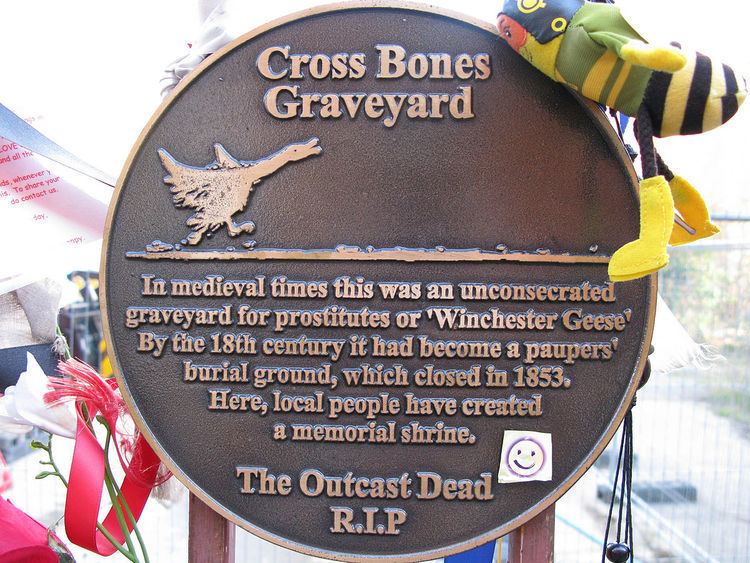 | ||
Cross Bones is a post-medieval disused burial ground in The Borough, Southwark, south London, in what is now known as Redcross Way. Thanks to volunteers, the Garden of Remembrance is open to visitors from 12noon till 3pm on weekdays and some Saturdays.
Contents
Origins and closure
Cross Bones is on the east side of Union Street bounded by properties on Borough High Street. It was closed in 1853 because it was "completely overcharged with dead", and further burials were deemed "inconsistent with a due regard for the public health and public decency". Southwark poet and playwright John Constable writes that, in 1883, the land was sold as a building site, prompting an objection from Lord Brabazon in a letter to The Times, asking that the land be saved from "such desecration".
Constable writes that the sale was declared null and void the following year under the Disused Burial Grounds Act 1884, and that subsequent attempts to develop the site were opposed by local people, as was its brief use as a fairground. However, after removal of remains to the parish facilities at Brookwood the site was covered in warehousing and other commercial buildings. The Jubilee Line Extension required this and other neighbouring sites to be used for construction purposes and a new electricity sub station. This required a formal archaeological dig as a requirement of the comprehensive redevelopment of the site.
Excavation
Excavations were conducted on the land by the Museum of London Archaeology Service between 1991 and 1998 in connection with the construction of London Underground's Jubilee line. Southwark Council reports that the archeologists found a highly overcrowded graveyard with bodies piled on top of one another. Tests showed those buried had suffered from smallpox, tuberculosis, Paget's disease, osteoarthritis, and vitamin D deficiency.
A dig in 1992 uncovered 148 graves, dating from between 1800 and 1853. Over one third of the bodies were perinatal (between 22 weeks gestation and seven days after birth). A further eleven percent were under one year old. The adults were mostly women aged 36 years and older.
The Southwark Mysteries
It is believed by John Constable, a local author, to have been established originally as an unconsecrated graveyard for "single women", a euphemism for prostitutes, known locally as "Winchester Geese", because they were licensed by the Bishop of Winchester to work within the Liberty of the Clink. However, this is pure supposition and a wilful reinterpretation of a remark about another cemetery by John Stow in Maiden Lane, Bankside(1525–1605) referenced in A Survey of London in 1598 calling it the "Single Woman's churchyard".
Stow was writing long after the Reformation. The evidence that exists and was itemised in the formal excavations by the Museum of London team, the age of the graveyard is known from the parish records. By 1769, it is clearly acquired as a new cemetery servicing the poor of St. Saviour's parish. Up to 15,000 people are believed to have been buried there.
Beginning in 1996, local writer John Constable invented the story of Cross Bones. The Southwark Mysteries is a cycle of poems and mystery plays inspired, he writes, by the spirit of a "Winchester Goose" (prostitutes licensed by the Bishop of Winchester) and "the outcast dead". The work has been performed in Shakespeare's Globe and in Southwark Cathedral. Interest generated by The Southwark Mysteries inspired the Cross Bones Halloween festival, celebrated every year since 1998 with a procession, candles and songs as part of John Constable's self promotional activities.
The graveyard is now established as a site of local importance: Southwark Council nominated it for a blue plaque in 2005. An informal local group, Friends of Cross Bones, is campaigning for a permanent memorial garden, and is instrumental in the halloween events. The graveyard gates in Redcross Way are permanently decorated by a changing array of messages, ribbons, flowers and other tokens; a short memorial vigil ceremony is held at the gates on the 23rd of each month in the early evening.
